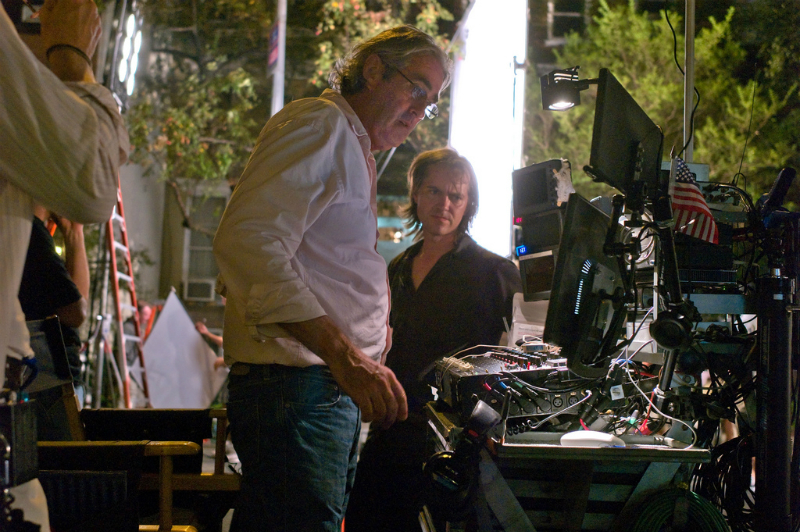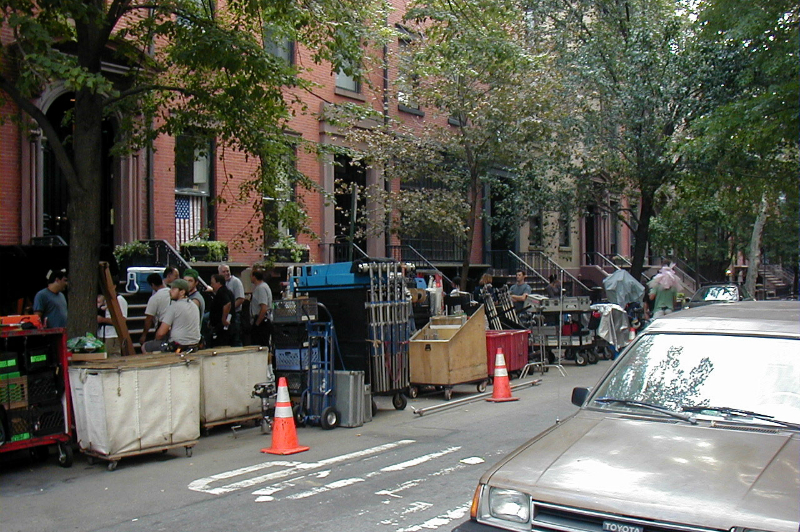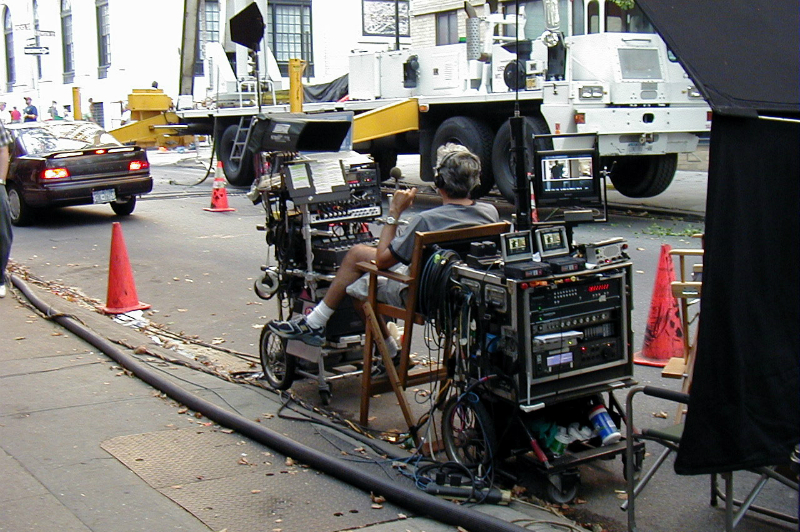
 Mayor's Office of Media and Entertainment311
Mayor's Office of Media and Entertainment311 Search all NYC.gov websites
Search all NYC.gov websites
TV/Film



A production crew - big or small - has structure; each member of the crew plays a unique and critical role in the filmmaking process. Like any industry, the production community has its own language, a glossary of terms used on set every day.
Glossary of Film Terms
Have you ever wondered what those weird sounding jobs on a film shoot are? Have you ever wondered how each crew member on a film shoot works with the other? Check out our Glossary of Film Terms to learn more.
# | A | B | C | D | E | F | G | H | I | J | K | L | M | N | O | P | Q | R | S | T | U | V | W | X | Y | Z
"Abby Singer"
The penultimate shot of the day. Named for an Assistant Director known for calling “Last Shot” when he really wanted to do one more afterwards.
"Action"
The Director or Assistant Director's cue to the actors that shoot is beginning. Camera and Sound Departments are called earlier with the command, "Roll," "Roll, Please" or "Rolling."
Added Scene
Scene that is added after the script is finished. Typically these scenes will be labeled with an "A", i.e. a scene added between scenes 1 and 2 is called scene "A2"
Associate Producer
Producer typically responsible for post production work.
Atmosphere, Background
Term for extras in a scene. The Assistant Director will call "Background" or "Background Action" so that these extras will begin their work just before the main actors are cued. ND Atmosphere or ND Car is where ND stands for "non-descript." This is when the Director wants extras or vehicles that will make the scene realistic but won't distract the audience from the action. ND extras and cars can be reused.
Back To One, Reset, From The Top, Same Again Please
Terms which all mean that the cast and crew should return to their initial positions to prepare for another take.
Bells
Usually a Set PA will ring a loud bell three times, to let everyone know to be quiet during sound recording. The mixer will ring the bell one more time to signal that recording is done.
Best Boy
Assistant to the Chief Lighting Technician, Assistant to the Gaffer or Assistant to the Key Grip.
Boom Person
Holds and positions the boom, an adjustable pole with a microphone on the end. Sometimes this person will use a Boom Crane.
Call Sheet
Master Sheet issued daily telling cast and crew where and when they are needed to report for the day of shooting. Includes critical information for a PA on set.
Camera Ready
When the camera and lighting are set up for a shot to begin. Getting the Actors “camera ready” means completing all the details for costume and make-up.
Cameraman, Cinematographer, Director Of Photography or First Cameraman
All refer to person responsible for overseeing camera work on a film who makes decisions on lighting, framing shots, and which lenses to use.
Camera Operator
Person in charge of the physical operation of camera during a shot.
First Assistant Camera Person
Camera Crew Member who takes care of the camera, changes lenses, focuses the camera, and takes measurements on the set.
Second Assistant Camera Person or Loader
Assists the First Camera Person with loading and unloading film, preparing camera reports and marking cast positions. In charge of the Clapboard to signal beginning and end of takes. Standard on union films and sometimes optional on a non-union crew.
Caterer
Provides meals to the Company if food is not readily available at a nearby restaurant.
Craft Service Person/Crafty
Responsible for providing food and drink for the cast and crew.
Clearance
Permission to use materials in a film (such as music or names of real people) that may be restricted by trademarks and regulations.
Condor
Large outdoor crane holding a camera, lighting and crew.
Cover Set
A back-up set where the film/show can shoot regardless of weather conditions.
Crew Call
Time listed on the “call sheet” when the majority of the crew is expected to arrive at the studio or location of the shoot.
"Cut"
Called by the Director or Assistant Director to signal the end of a take so that the camera and sound crew stop “rolling.”
Dailies
The initial screenings of recently shot, unedited footage by the Director and Cast and Crew Members or Studio Executives who are invited.
Day For Night
Shooting a night sequence (often only one shot) during day light.
Day Out Of Days
Working schedule for the Cast Members. Includes information on when Actors are on 'hold' (still paid but not scheduled to work), and are unavailable due to traveling.
Day Player
Actor who only works on the film for a short time and is paid at a daily rate.
DGA
Directors Guild of America. A Union for Directors, Assistant Directors, Unit Production Managers, Technical Coordinators, Associate Directors, Stage Managers, and sometimes Production Associates.
Establishing Shot
A short, typically wide-angle shot that tells the audience where the story takes place; i.e. a shot of the Manhattan skyline for a film taking place in NYC.
Executive Producer
Senior to all other producers on a project, this person can be in charge of anything from fundraising to marketing to making decisions about production. Executive Producer on a TV show usually means the creator of the series.
First Team
Call for Actors, Director, Script Supervisor and Mixer, if necessary, to take their places for a rehearsal.
Gaffer or Chief Lighting Technician
Oversees lighting set-up as per instructions from the Director of Photography. Term comes from “Gaff,” a pole with a hook on the end used to move hanging lights.
Grip
Responsible for moving, basic construction and set-up of equipment to rig the set. Grips are ranked in order of Key Grip, Second Grip (Best Boy), and Company Grip.
Hiatus
Usually enforced and unpaid shutting down period for a Production Company.
Honeywagon
Large trailer with small dressing rooms, hair and make-up rooms, and often production offices. It serves as the base of production on location. Actors, Directors and Producers will often have their own trailers during movie shoots.
Hot Set
Term for a set that has been photographed but should not be altered in any way because it may be used for shooting later. Sometimes it will be indicated with signs.
IA or IATSE
International Alliance of Theatrical Stage Employees. The union that includes most film technicians.
Insert Car or Camera Car
The rolling platform that the camera crew rides on to shoot action scenes involving fast movement. Sometimes the Camera Car can involve cranes and other equipment.
Line Producer
Production Executive or Supervisor responsible for day-to-day production.
Location Manager
Responsible for scouting and obtaining permission to use locations, and for making sure that things go smoothly in communities.
"Lock It Up"
Called to secure the set or location during a shoot, mostly during stunt work.
Losing The Light
Since there are a limited number of hours of sunlight during the day, crews fear “losing the light” and begin filming exteriors as early in the morning as possible.
Magic Hour
Dusk. A brief time period when exterior lighting conditions become more cinematic because of the sunset.
Master
A long take of a scene shot from start to finish at an angle that allows the widest view of all of the action. It acts as a blueprint for the scene. Watching the “master” would be like watching a filmed play, without all of the close-ups and alternate angles which are edited in later. The additional shots (i.e. two-shot, single, over the shoulder, close-up) are called Coverage.
Martini
Crew jargon for the final shot of the day. In the 1940's, the crew might go out for martinis after the "martini."
Meal Penalty
Compensation the Company must give to Cast, Extras and Crew when they violate contractually agreed upon meal times.
MOS
Term to indicate that a shot should be filmed without sound.
One-Liner
An abbreviated schedule indicating what scenes are being filmed when. It is constantly being changed during production.
Parking Coordinator
Supervises the Parking PAs.
Parking Production Assistant (PA)
Crew used to secure street parking both in advance and during a shoot for all necessary trucks and production vehicles.
"Pick Up"
Called by a Director when they are not satisfied with the entire shot. The scene will be partially re-shot, instead of starting at the beginning of the scene.
"Picture's Up"
Called by the Assistant Director to indicate that the next run through a scene will be committed to film. Everything should be picture perfect.
Picture Vehicle
A designated vehicle that will be seen on camera as opposed to a vehicle required to transport equipment and personnel.
Practical
A particular prop, fixture or piece of the set dressing designated to work as though it were real, i.e. sinks with running water, stoves connected to gas lines, etc.
Pre-Rig
To prepare elements required for filming prior to the arrival of the Main Unit; i.e. electrical cables installed on location before the arrival of the shooting crew.
Production Assistant (PA)
An entry level position offering administrative and organizational support often in various different departments of a production.
Prop Master
Oversees prop department. Responsible for ensuring props for a given scene are available when and where they are needed. Works with the Director and Art Director to determine the size, shape and "look" of the props used.
Retake
Type of re-shooting decided by the Director and Producer. Decision based on dislike of a performance or a technical issue. If possible, most sets and locations are kept in the same state as when the footage was shot until the “Dailies” are viewed.
"Roll" ("Roll, Please" or "Rolling")
Called by an Assistant Director advising the Sound Director to “Roll” sound and the Camera Operator to standby to begin running film through the camera, prior to the call for "Action!" Sound must be brought up to a certain speed before the camera can be slated and the Director can call "Action!" If the "roll" is called and the 1st Assistant Director notices the set is not ready, they will call “Holding the Roll” until they call “Rolling” to begin.
SAG
Screen Actors Guild. A bargaining unit for actors, including stunt people.
Script Advisor
Crew Member who stands close to camera and monitors/documents any changes in the script to maintain visual continuity.
Second Meal
A break for dinner rather than work exceptionally long hours. For all night shooting where your first meal will be known as “lunch” and “second meal” as "dinner."
Second Team
Refers to a STAND IN who stands in place of the actors during the setting of the lights in order to enable cast to have time for hair/make-up, line rehearsal, etc.
Second Unit
Separate Filming Unit (including its own Director and Camera Crew) that shoots portions of the script that are too tedious, time consuming, dangerous and expensive for the Main Shooting Unit; i.e. a lengthy truck-chase sequence.
Set Dressing
Decorative items for the set that are organized by Set Director and are not specifically called for by the Director or script, nor directly handled by the actor. Set Director’s crew consists of Leadman and Swing Gang.
Set Production Assistant (PA)
Crew used to balance the needs of the production and residents by enlisting the cooperation of the community to get necessary shots.
Shooting Call
Time on Call Sheet when all actors and crew are expected on set and ready for the first shot.
Squib
Small, electronically detonated explosive used to simulate kinetic effect (i.e. bullet hits). Used with blood sacs to create the effect of a person being hit by a bullet.
Stand In
An Actor's "Double" whose characteristics are similar to the Actor. Used for some medium and long shots where it isn’t necessary to see the Actor’s face.
Strike
To dismantle a set or simply stow away equipment at the end of a shooting day.
Swing Gang
Crew Members who assist the LEAD PERSON in preparing sets for film, clean up debris, organize set dressings and return props to proper locations, etc.
Teamsters
National union of truck drivers and associated workers who drive all trucks and production vehicles to and from location.
Ten-One Hundred
(10-100) Slang used to indicate going to the bathroom.
Turnaround
Term for the Rest Period required by the union in between being dismissed from the set and arriving at the set the next day.
Waiver
1) A procedure when the Company wants permission to violate a condition of a labor contract with the Guild or Union. If approved, the Guild or Union will then “grant a waiver.”
2) Refers to Non-union Extras when the Company that employs them is signatory to the SAG agreement.
Walkaway
1) When everything is left exactly as is at the end of the day.
2) When there is no catered lunch and the crew breaks in the neighborhood to eat.
Walkie Talkie or Walkie
Handheld two-way radio used by film crew to communicate.
Will Notify
When an Actor is obligated to remain in close touch with the Assistant Director(s).
"Wrap"
Indicates that the actors can be dismissed for the day and lets the crew know that they should either begin or continue duties required at the end of the day.


